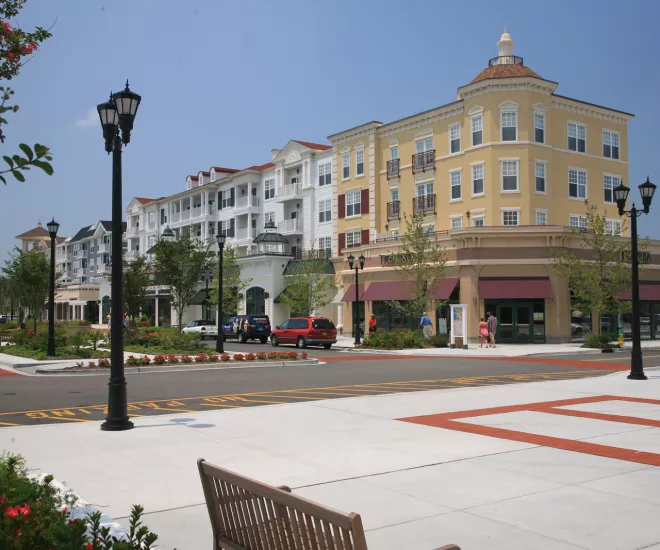Veterans Remembered in the Street Names of The Market Common

When the Myrtle Beach Air Force Base Redevelopment Authority headed by Colonel Buddy Styers, USAF, Retired, transformed the former base into what is the Market Common District today, part of the scope of their work was to submit names to the City of Myrtle Beach for all of the new streets that were being made that reflected the rich military history of the area. When I take guests around the district and share that military history, I use the street names as a template for the stories that I tell them.
When I first did the research behind those names, I immediately began to associate the men’s biographies with the corresponding streets that I happened to be driving on. For weeks, I would literally tear up every time I would turn on Shine Avenue once I learned about the decorated MIA, Tony Shine, and how his eight-year-old daughter embarked on a quest to make sure that her late father didn’t remain missing.
Here is a list of only some of the veterans whose names appear on the street signs. In most cases, historical markers are placed close to those signs so passersby can stop for a moment and read about these heroes.
Barton Circle
Named for Colonel Joe Barton, USAF, Retired, (Some sources claim that it is named for a former base commander who happened to have the same last name. As there is no historic marker along that particular circle to confirm the actual person for whom it is named, and there is a marker in Warbird Park for Joe Barton, I choose to attribute the name to him. He is also the host of a catered reception that is held for my guests during which he gives an engaging and informative presentation with a slideshow of the base’s history.)
Colonel Barton was literally the last man to leave the Myrtle Beach Air Force Base when it closed on March 31, 1993. He also flew the A-10 in Desert Storm that is on static display in Warbird Park. You can see from the nose art, that he called the plane the Dawg Hawg, which combines the mascot Bulldogs (affectionately known as Dawgs) of his beloved alma mater, The University of Georgia, and the nickname for the plane, The Warthog, because of its less than attractive appearance if compared to sleeker, faster jets in the Air Force.
Crabtree Lane
Named for Clem Crabtree
This street terminates at Crabtree Gym which was also named for Clem Crabtree after his death in January of 1981. At that time, he was still the head of Morale, Welfare and Recreation for the base. When he arrived in Myrtle Beach in the mid-1960s, he oversaw the construction, management and expansion of the gym. Before joining the Air Force, Clem was in the NFL and played for the Detroit Lions during their 1940 and 1941 seasons.
Curtis Brown Lane
Named for Colonel Curtis S. Brow
The MIT-trained Brown was an A-10 pilot stationed in Myrtle Beach in the late 1970s. In August of 1988 he completed his astronaut training. And, in the late 90s, he flew six Space Shuttle missions; three as pilot and three as commander.
Emmens Avenue
Named for Colonel Robert Emmens
His claim to fame was that he was one of Jimmy Doolittle’s Raiders who, on April 18, 1942, were the 80 men on 16 B-25 Mitchell bombers who attacked Japan for the first time after Pearl Harbor. None of the planes made it to the rendezvous site in China after each successfully carried out their mission. Emmens’ crew were the only ones to land on a runway. But it was in Russia and they were consequently taken as Prisoners of War to appease Japan and keep that country from attacking Russia. Emmens was the first commander of the Myrtle Beach Air Force Base who oversaw its construction from 1954 to 1956. A residential community in the district, Emmens Preserve, is named for him as well.
Farrow Parkway
Named for Lieutenant William Farrow
Farrow was a South Carolina native who was also a Doolittle Raider who became a POW. Unfortunately, he was captured by the Japanese, stood trial and was sentenced to death. In October of 1942, he, his gunner and another pilot faced a firing squad. During the base’s days there was a major thoroughfare near the hospital called Farrow Boulevard. When the Market Common District was laid out, its major road, running from one end to the other, was also named after Farrow. I presume, since Emmens was in charge of the base’s construction, he took the opportunity to honor his fallen comrade.
Gabreski Lane
Named for Colonel Francis Gabreski
Before Gabreski passed away in 2002, he was considered our country’s greatest living flying ace. So Myrtle Beach had a national hero at the helm when the base officially opened on December 7, 1956. Some guests from the Long Island area of New York tell me about an airport near where they live named for him. On a personal level, he was also known for having quite a large family. While most officers lived in the duplexes of Woodland Park base housing, the Gabreskis had to remove a wall and take over two duplexes to accommodate all of their children.
Howard Avenue
Named for Brigadier General James Howard
This recipient of the Medal of Honor for what was called, in October of 1944, the greatest display of combat flying ever witnessed, was the guest of honor in Myrtle Beach for the Reactivation Ceremony for the 354th Fighter Day Wing. That was the unit initially assigned to the base. Howard had been a member of the original 354th during World War II. The plane he and his fighter group flew was the P-51 Mustang. On the shield of the new 354th there is a mustang horse featured in the upper right corner as a nod to Howard and his fellow pilots.
Johnson Avenue
Named for Captain Paul Johnson
He was the recipient of the Air Force’s highest honor, the Air Force Cross, for an extraordinary mission that he completed during Desert Storm. It required him to fly deeper into enemy territory than a Warthog had ever flown before, sometimes only 500 feet above ground in order to locate a downed Navy pilot.
Phillis Boulevard
Named for Captain Stephen Phillis
The only pilot that the Myrtle Beach Air Force Base lost in Desert Storm was Stephen Phillis on February 15, 1991. During a mission over Kuwait, his wingman radioed him that he had been hit and would have to eject. Once he did, Phillis doubled back to pinpoint where his friend most likely would land with the parachute in order to direct others to rescue him but encountered enemy aircraft which he began strafing in order to buy his friend time. Consequently, Phillis received return fire and perished when his plane crashed in the desert.
Shine Avenue
Named for Lieutenant Colonel Anthony C. Shine
In 1996, Tony Shine’s remains were interred at Arlington National Cemetery after having been MIA since 1972 when his plane disappeared over North Vietnam. His young daughter at the time grew up and dedicated her career to helping families of MIAs and POWs. Her connections led her to evidence that his crash site may have been found. She went to Vietnam on her own, confirmed that it had, and had her daddy brought home.
Styers Way
Named for Colonel Thomas C. “Buddy” Styers, USAF, Retired
No, Buddy did not name a street for himself. On the day of the grand opening of The Market Common in 2008, the developer with whom he had been working closely suggested that they go to P.F. Chang’s for lunch after the ceremony. When they reached the corner of the block on which the restaurant sits, the developer pointed out that there was a street sign that had yet to be unveiled and suggested Buddy do the honors. When he did, the sign for Styers Way was revealed. The developer had secretly submitted that name to the City of Myrtle Beach in order to surprise the retired colonel and thank him for all of his hard work.
